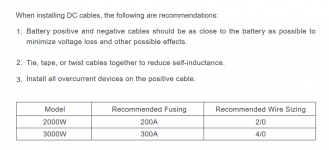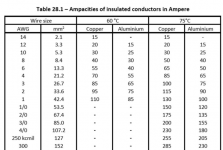ee.van
Member
- Location
- Calgary, AB
- Occupation
- EE
Hi Mike,
My 3000W inverter has recommended a 4/0 cable paired with a 300A class T Fuse. I would likely use welding cable for flexibility.

I always double check UL Table 28.1, which states that 4/0 copper cable is only rated for 230A.

This Chart from Blue Sea Power (doesn't go up to 300A) indicates that 2/0 Battery Cable <20ft is suitable for 200A even though the chart above indicates that it is undersized when referencing table 28.1.

I've always been taught that its amperage that affects the wire size, so my gut feeling is off on this one.
Thanks for the help and expertise
My 3000W inverter has recommended a 4/0 cable paired with a 300A class T Fuse. I would likely use welding cable for flexibility.

I always double check UL Table 28.1, which states that 4/0 copper cable is only rated for 230A.

This Chart from Blue Sea Power (doesn't go up to 300A) indicates that 2/0 Battery Cable <20ft is suitable for 200A even though the chart above indicates that it is undersized when referencing table 28.1.

I've always been taught that its amperage that affects the wire size, so my gut feeling is off on this one.
Thanks for the help and expertise
